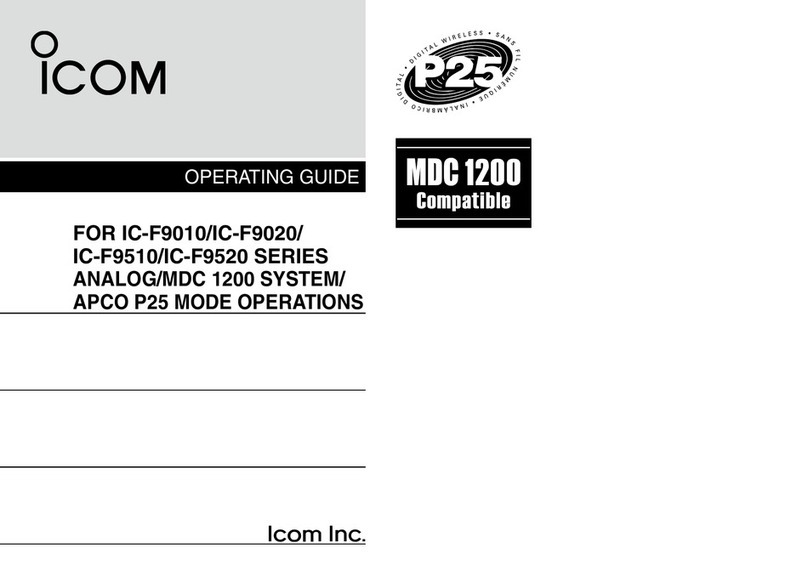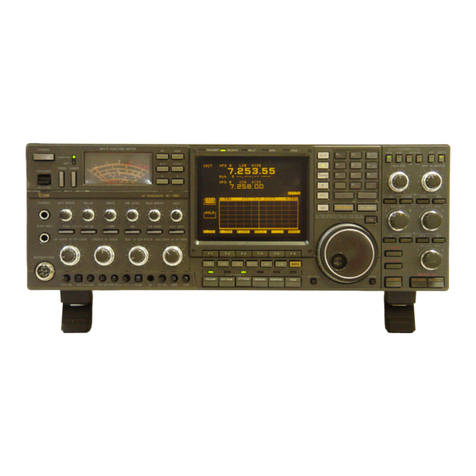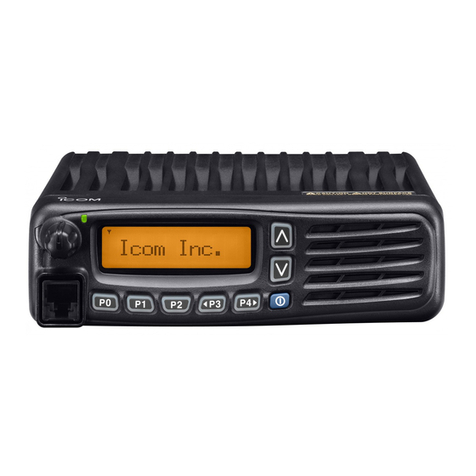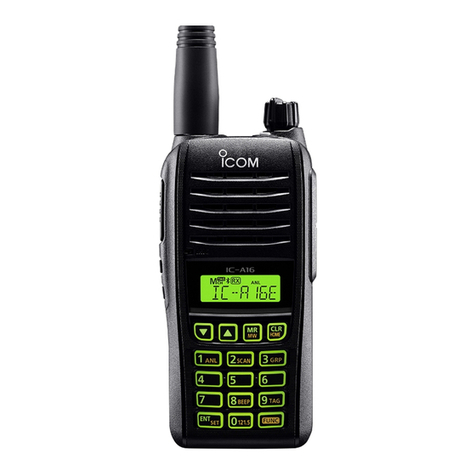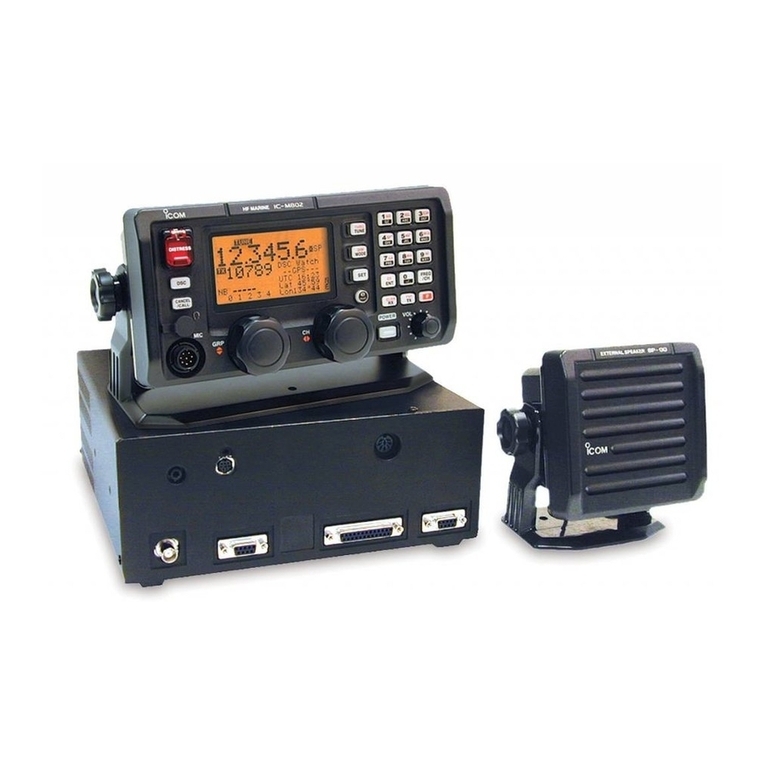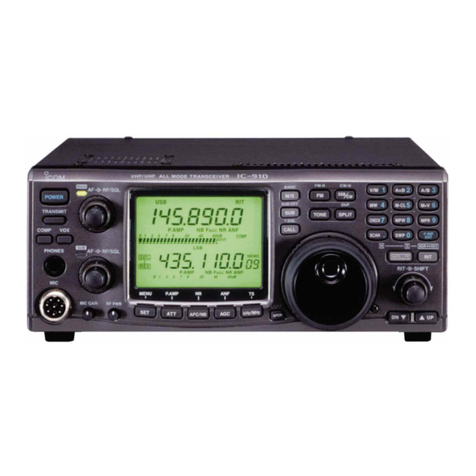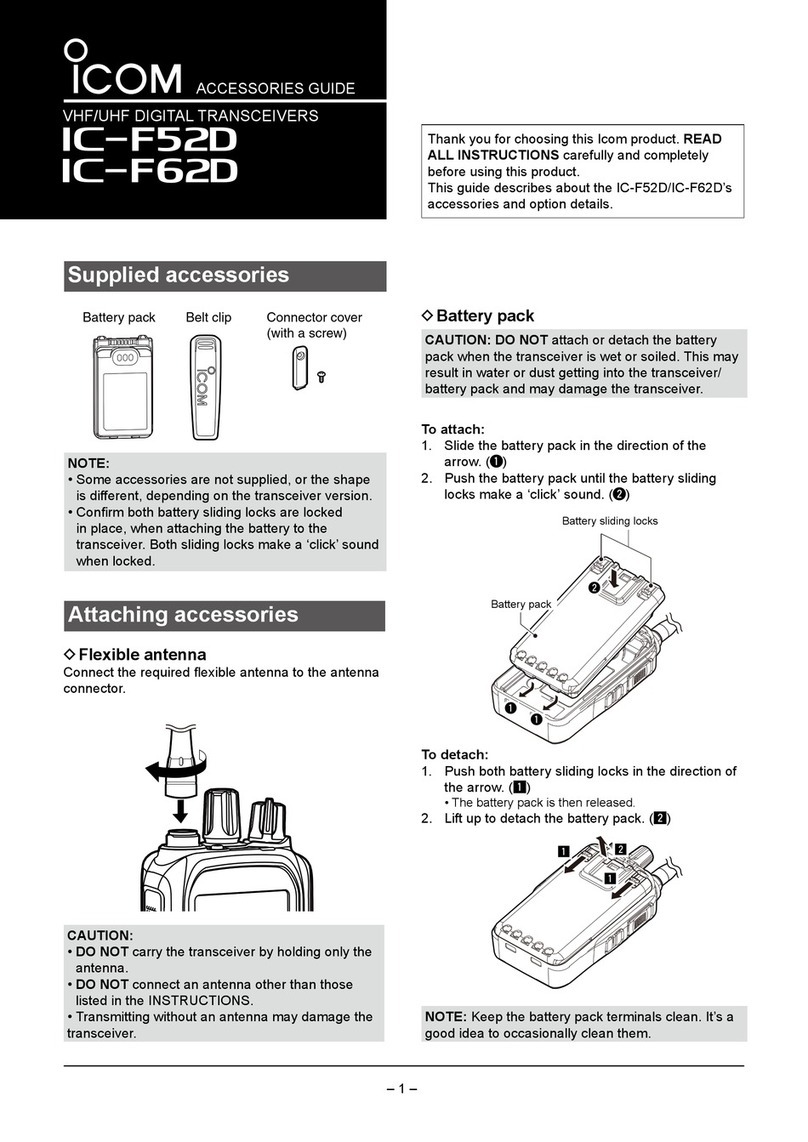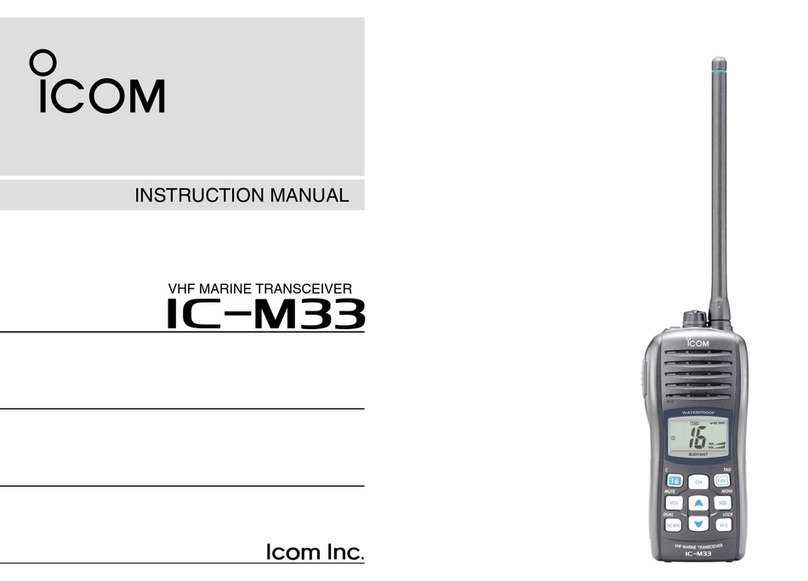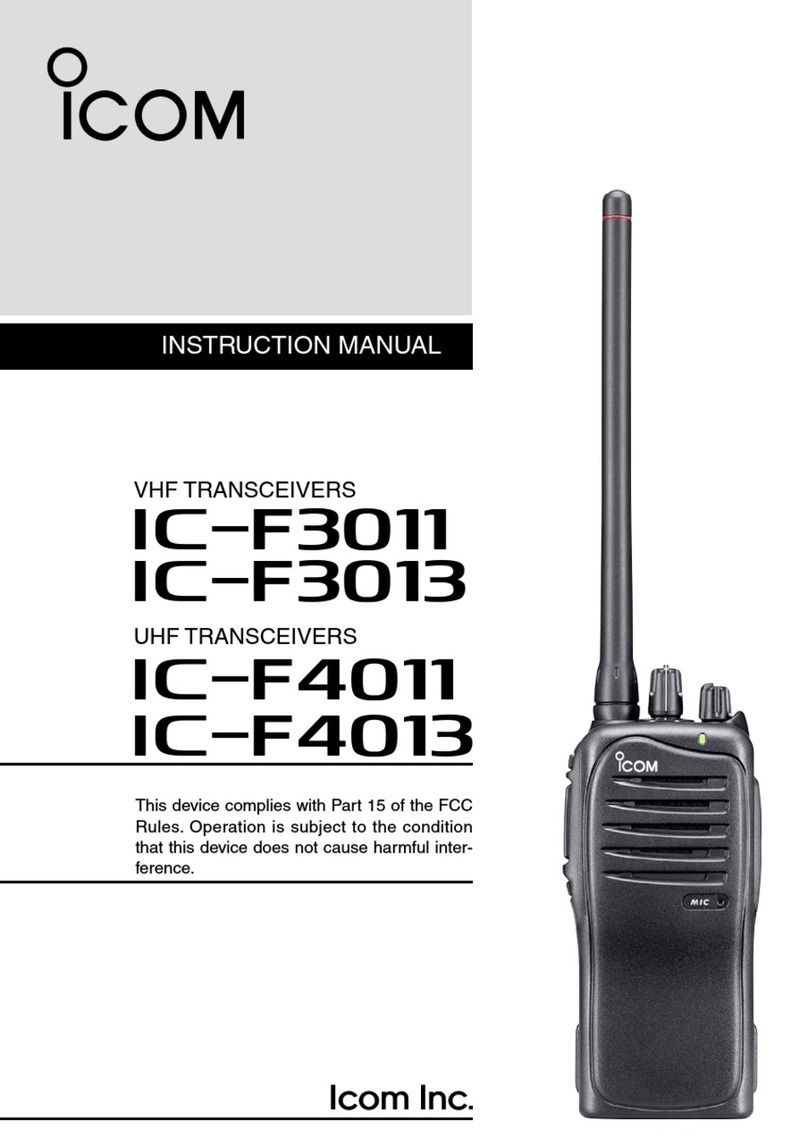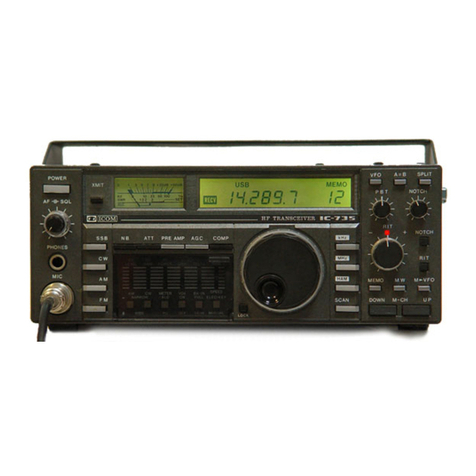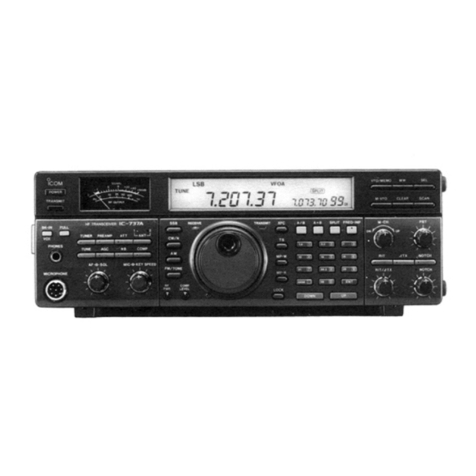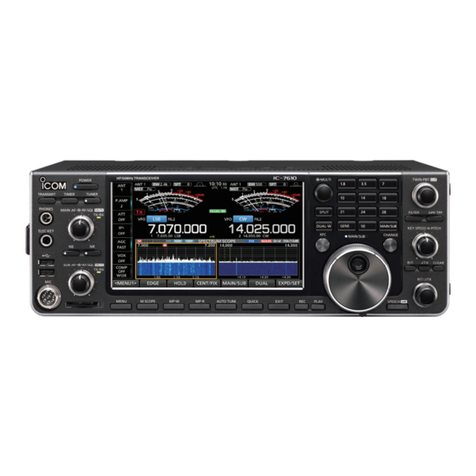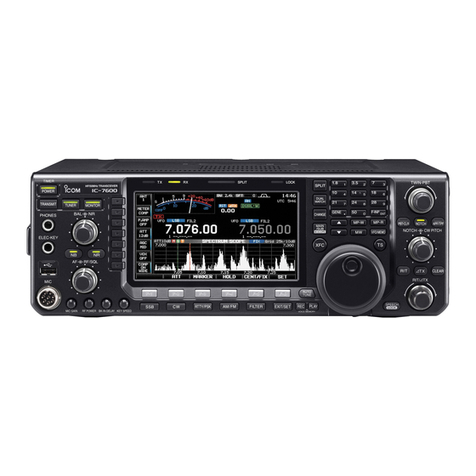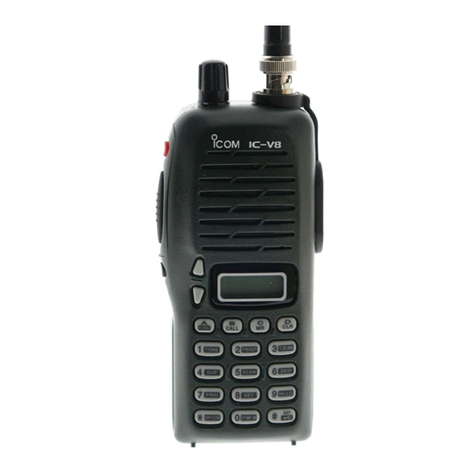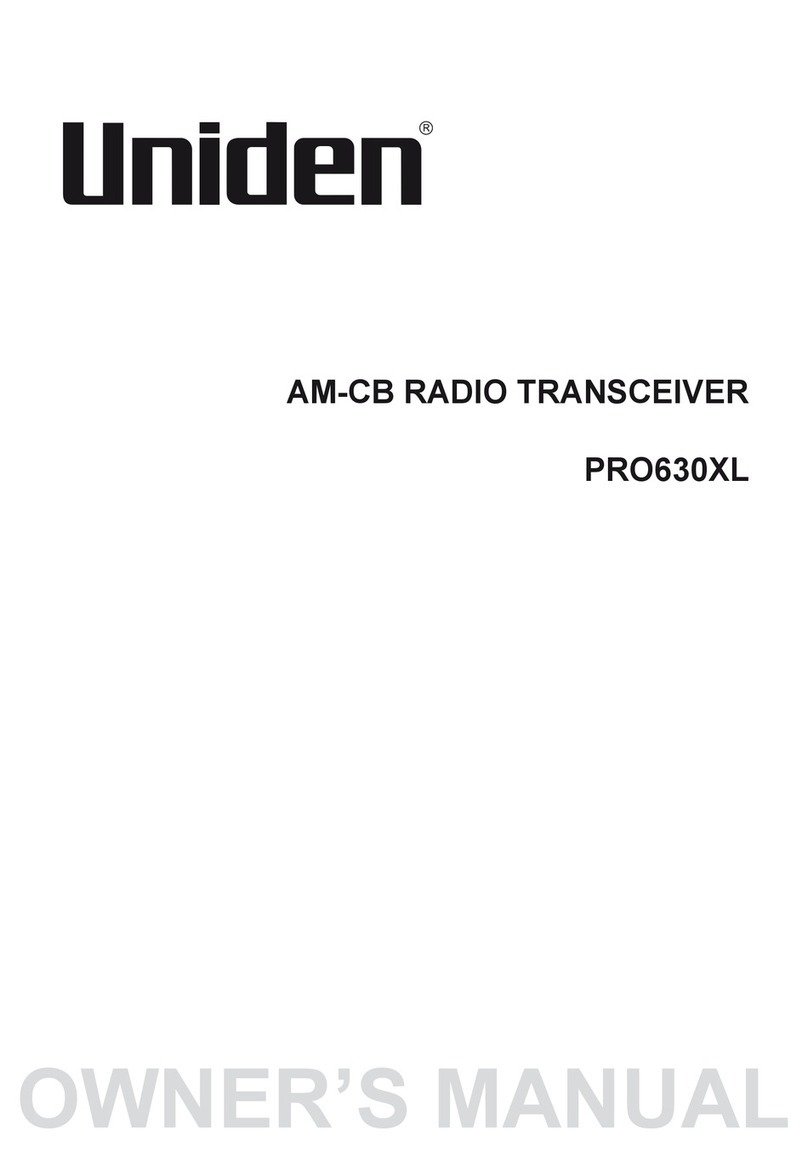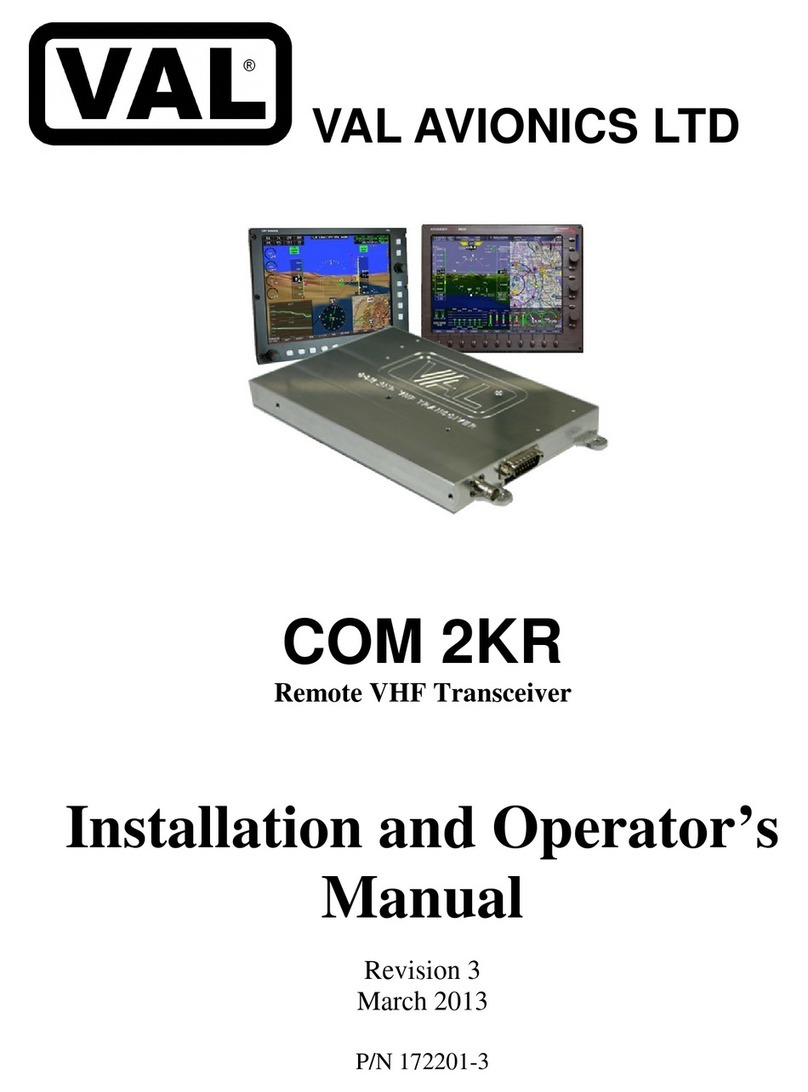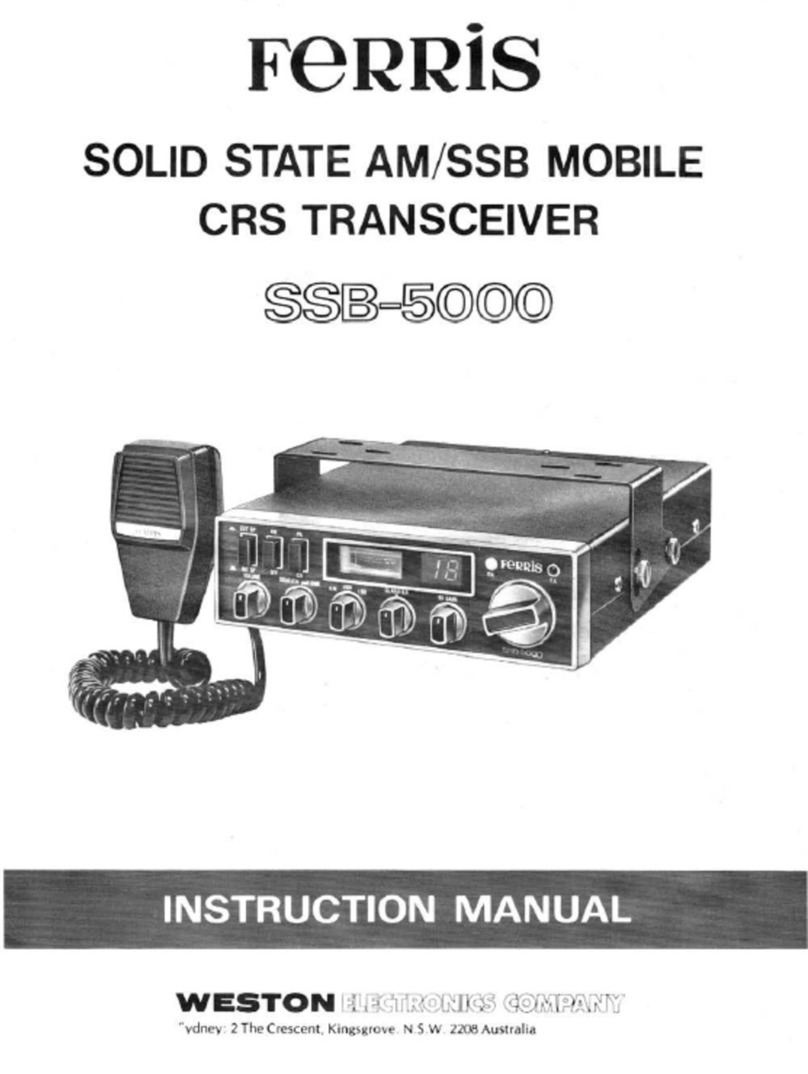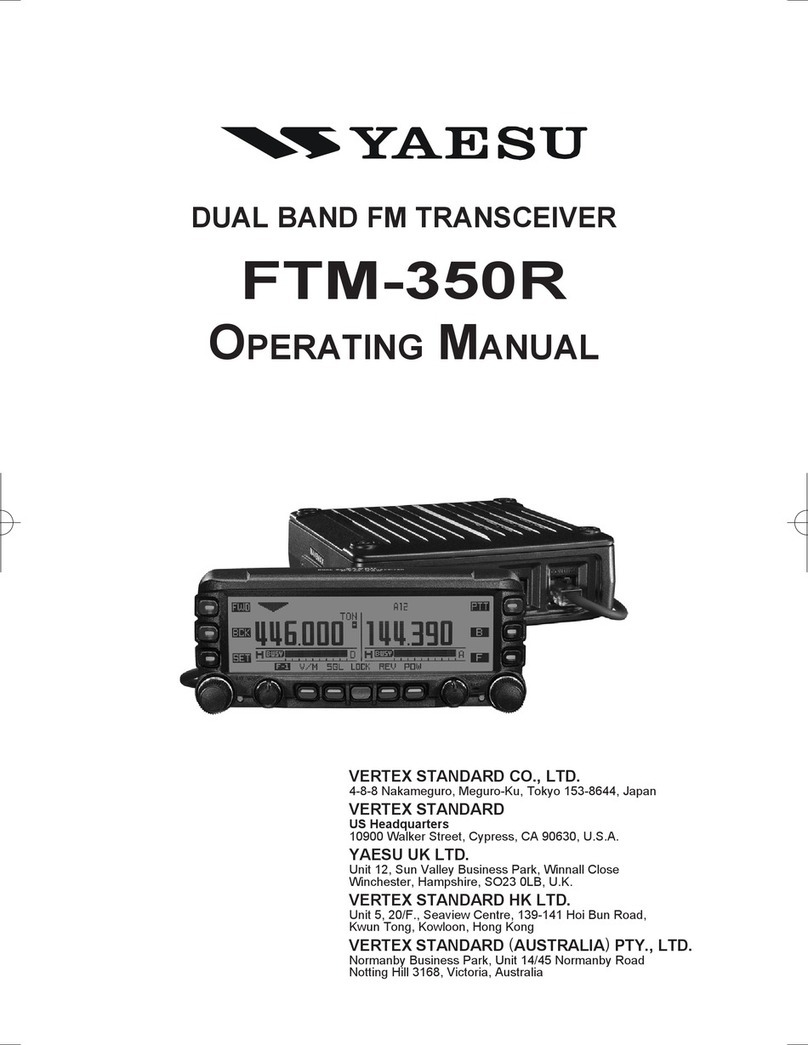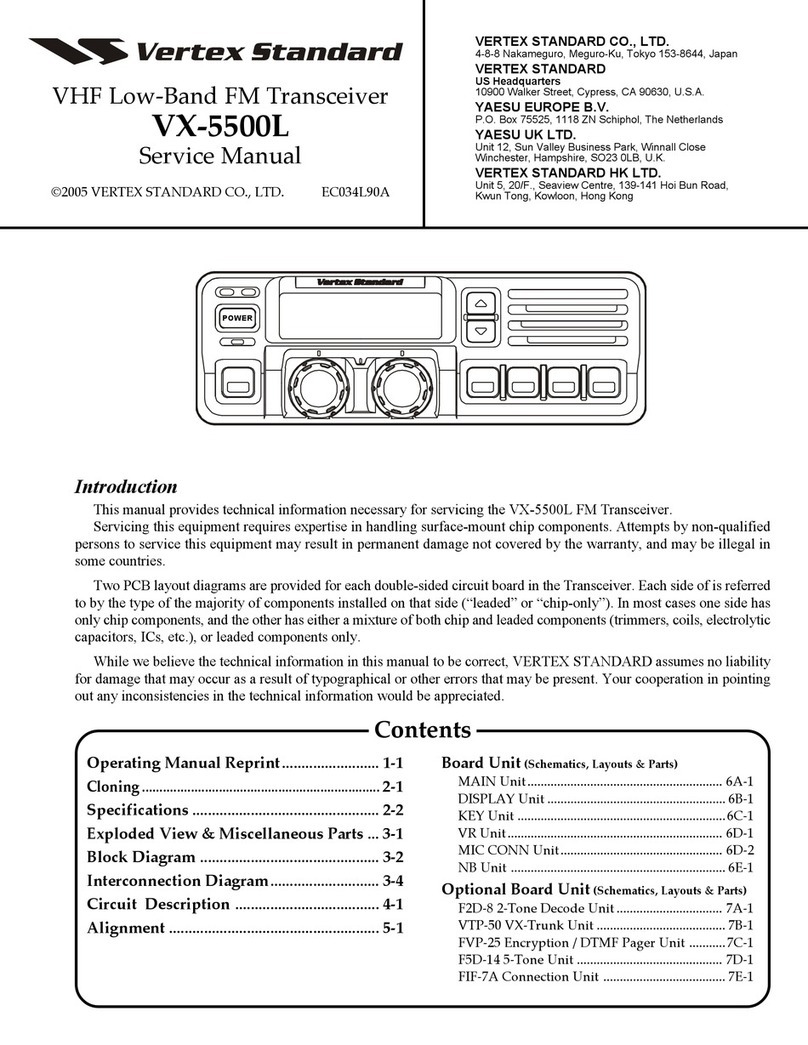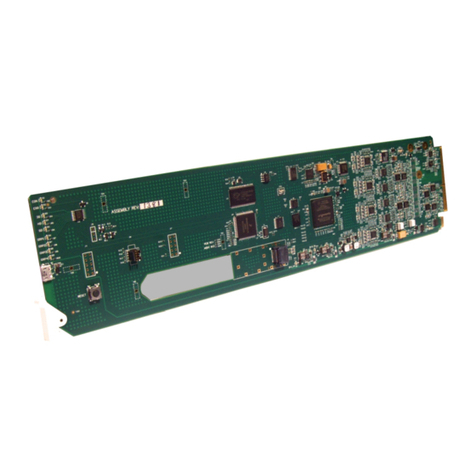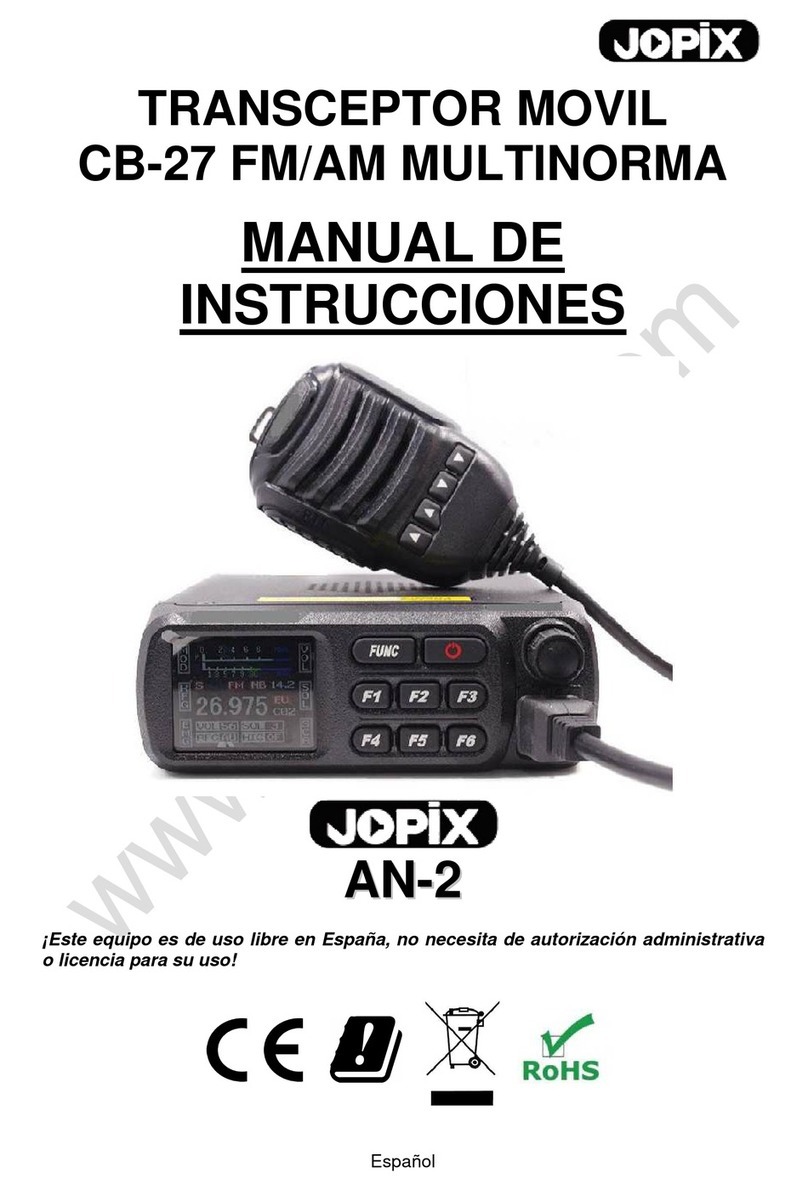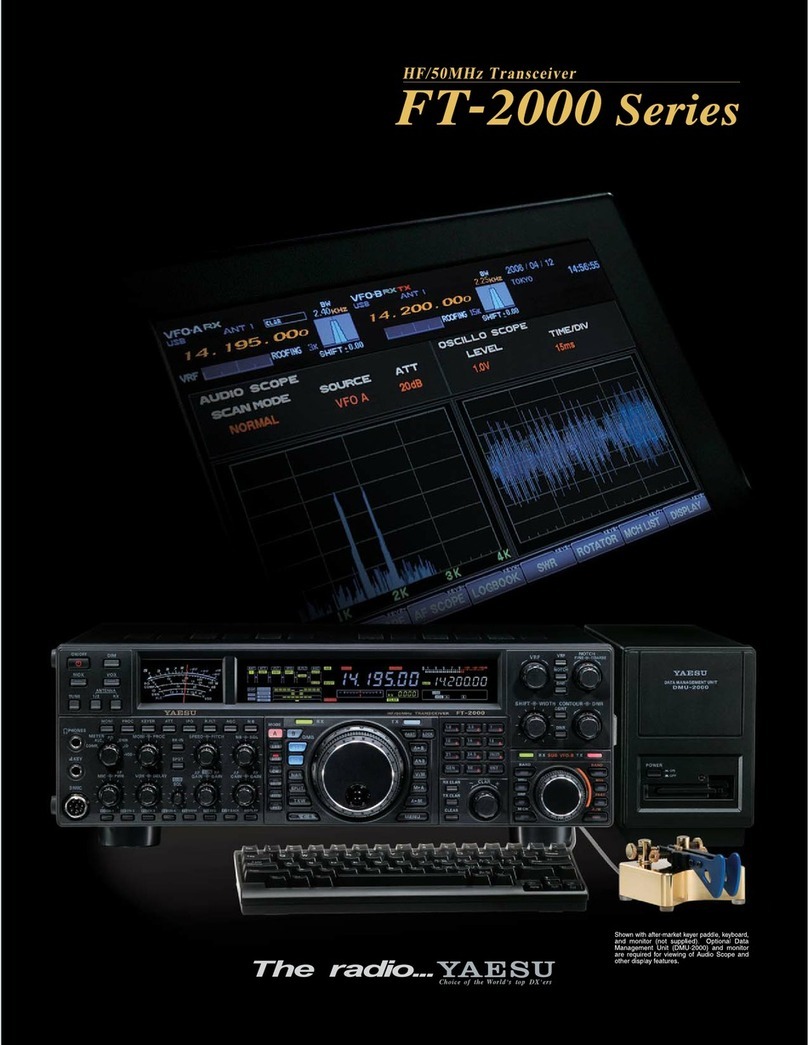Icom IC-T3H Manual

INSTRUCTION MANUAL
VHF TRANSCEIVER
iT3H

FOREWORD
Thank you for purchasing the IC-T3H FM transceiver. This
transceiver is designed for those who require quality, perfor-
mance and outstanding reliability under the most demanding
conditions.
IMPORTANT
READ ALL INSTRUCTIONS carefully and completely before
using the transceiver.
SAVE THIS INSTRUCTION MANUAL– This instruction manual
contains important operating instructions for the transceiver.
EXPLICIT DEFINITIONS
The explicit definitions below apply to this instruction manual.
i
Icom, Icom Inc. and the are registered trademarks of Icom Incor-
porated (Japan) in the United States, the United Kingdom, Germany,
France, Spain, Russia and/or other countries.
WORD DEFINITION
RRWARING Personal injury, fire hazard or electric chock
may occur.
CAUTION Equipment damage may occur.
NOTE If disregarded, inconvenience only. No risk of
personal injury, fire or electric shock.

ii
SUPPLIED ACCESSORIES
Accessories included with the transceiver:
qAntenna . . . . . . . . . . . . . . . . . . . . . . . . . . . . . . . . . . . . 1
wBelt clip. . . . . . . . . . . . . . . . . . . . . . . . . . . . . . . . . . . . . 1
e2251 OPT sheet . . . . . . . . . . . . . . . . . . . . . . . . . . . . . . 1
rAC Adapter* . . . . . . . . . . . . . . . . . . . . . . . . . . . . . . . . . 1
tBattery pack*/Battery case* . . . . . . . . . . . . . . . . . . . . . 1
yBattery charging stand* . . . . . . . . . . . . . . . . . . . . . . . . 1
*Not supplied with some versions.
r
q
w
e
t
y

iii
PRECAUTIONS
RWARNING! NEVER hold the transceiver so that the
antenna is very close to, or touching exposed parts of the body,
especially the face or eyes, while transmitting. The transceiver
will perform best if the microphone is 5 to 10 cm away from the
lips and the transceiver is vertical.
RWARNING! NEVER operate the transceiver with a
headset or other audio accessories at high volume levels. Hear-
ing experts advise against continuous high volume operation. If
you experience a ringing in your ears, reduce the volume or dis-
continue use.
NEVERconnect the transceiver to a power source that is DC
fused at more than 5 A. Accidental reverse connection will be
protected by this fuse, but higher fuse values will not give any
protection against such accidents and the transceiver will be ru-
ined.
NEVER attempt to charge alkaline or dry cell batteries. Be
aware that external DC power connections will charge batteries
inside the battery case. This will damage not only the battery
case but also the transceiver.
DO NOT push the PTT when not actually desiring to trans-
mit.
Place the unit in a secure place to avoid inadvertent use by chil-
dren.

iv
DO NOT operate the transceiver near unshielded electrical
blasting caps or in an explosive atmosphere.
AVOID using or placing the transceiver in direct sunlight or in
areas with temperatures below –10°C or above +60°C.
The use of non-Icom battery packs/chargers may impair trans-
ceiver performance and invalidate the warranty.
Even when the transceiver power is OFF, a slight current still
flows in the circuits. Remove the battery pack or case from the
transceiver when not using it for a long time. Otherwise, the bat-
tery pack or installed Ni-Cd batteries will become exhausted.

vi
TABLE OF CONTENTS
FOREWORD. . . . . . . . . . . . . . . . . . . . . . . . . . . . . . . . . . . . . . . . . . . . . i
IMPORTANT. . . . . . . . . . . . . . . . . . . . . . . . . . . . . . . . . . . . . . . . . . . . . i
EXPLICIT DEFINITIONS . . . . . . . . . . . . . . . . . . . . . . . . . . . . . . . . . . . i
SUPPLIED ACCESSORIES . . . . . . . . . . . . . . . . . . . . . . . . . . . . . . . . ii
PRECAUTIONS . . . . . . . . . . . . . . . . . . . . . . . . . . . . . . . . . . . . . . . iii–iv
TABLE OF CONTENTS . . . . . . . . . . . . . . . . . . . . . . . . . . . . . . . . . v–vi
1 PANEL DESCRIPTION . . . . . . . . . . . . . . . . . . . . . . . . . . . . . . . . 1–8
‘Switches, controls, keys and connectors. . . . . . . . . . . . . . . . . 1–6
‘Function display. . . . . . . . . . . . . . . . . . . . . . . . . . . . . . . . . . . . 7–8
2 ACCESSORIES . . . . . . . . . . . . . . . . . . . . . . . . . . . . . . . . . . . . . . . . 9
‘Accessory attachment. . . . . . . . . . . . . . . . . . . . . . . . . . . . . . . . . 9
3 BATTERY PACKS . . . . . . . . . . . . . . . . . . . . . . . . . . . . . . . . . . 10–15
‘Battery pack replacement . . . . . . . . . . . . . . . . . . . . . . . . . . . . . 10
‘Battery caution. . . . . . . . . . . . . . . . . . . . . . . . . . . . . . . . . . . . . . 11
‘Battery charging . . . . . . . . . . . . . . . . . . . . . . . . . . . . . . . . . 12–13
‘Charging NOTE . . . . . . . . . . . . . . . . . . . . . . . . . . . . . . . . . . . . 14
‘Battery case (optional for some versions) . . . . . . . . . . . . . . . . 15
4 BASIC OPERATION . . . . . . . . . . . . . . . . . . . . . . . . . . . . . . . . 16–20
‘Power ON . . . . . . . . . . . . . . . . . . . . . . . . . . . . . . . . . . . . . . . . . 16
‘Setting a frequency . . . . . . . . . . . . . . . . . . . . . . . . . . . . . . . 16–17
‘Setting audio/squelch level . . . . . . . . . . . . . . . . . . . . . . . . . . . . 17
‘Receive and transmit. . . . . . . . . . . . . . . . . . . . . . . . . . . . . . . . . 18
‘Selecting a memory channel. . . . . . . . . . . . . . . . . . . . . . . . . . . 19
‘Selecting the call channel . . . . . . . . . . . . . . . . . . . . . . . . . . . . . 19
‘Key lock function . . . . . . . . . . . . . . . . . . . . . . . . . . . . . . . . . . . . 19
‘Display type. . . . . . . . . . . . . . . . . . . . . . . . . . . . . . . . . . . . . . . . 20
5 REPEATER OPERATION . . . . . . . . . . . . . . . . . . . . . . . . . . . . 21–24
‘General . . . . . . . . . . . . . . . . . . . . . . . . . . . . . . . . . . . . . . . . . . . 21
‘Offset frequency . . . . . . . . . . . . . . . . . . . . . . . . . . . . . . . . . . . . 22
‘Subaudible tones. . . . . . . . . . . . . . . . . . . . . . . . . . . . . . . . . 22–23
6 MEMORY PROGRAMMING . . . . . . . . . . . . . . . . . . . . . . . . . . 24–26
‘General . . . . . . . . . . . . . . . . . . . . . . . . . . . . . . . . . . . . . . . . . . . 24

vii
‘Programming the memory/call channels. . . . . . . . . . . . . . . . . . 24
‘Channel name programming. . . . . . . . . . . . . . . . . . . . . . . . . . . 25
‘Memory transferring . . . . . . . . . . . . . . . . . . . . . . . . . . . . . . 25–26
7 DTMF MEMORY. . . . . . . . . . . . . . . . . . . . . . . . . . . . . . . . . . . . 27–28
‘Programming a DTMF code . . . . . . . . . . . . . . . . . . . . . . . . . . . 27
‘Transmitting a DTMF code. . . . . . . . . . . . . . . . . . . . . . . . . . . . 28
‘DTMF transmission speed. . . . . . . . . . . . . . . . . . . . . . . . . . . . . 28
8 SCAN OPERATION . . . . . . . . . . . . . . . . . . . . . . . . . . . . . . . . . 29–33
‘Scan types. . . . . . . . . . . . . . . . . . . . . . . . . . . . . . . . . . . . . . . . . 29
‘Programmed scan . . . . . . . . . . . . . . . . . . . . . . . . . . . . . . . . . . 30
‘Memory (skip) scan. . . . . . . . . . . . . . . . . . . . . . . . . . . . . . . . . . 31
‘Priority watch . . . . . . . . . . . . . . . . . . . . . . . . . . . . . . . . . . . . . . 32
‘Scan resume condition. . . . . . . . . . . . . . . . . . . . . . . . . . . . . . . 33
9 SUBAUDIBLE TONES. . . . . . . . . . . . . . . . . . . . . . . . . . . . . . . 34–37
‘Tone squelch . . . . . . . . . . . . . . . . . . . . . . . . . . . . . . . . . . . 34–35
‘Pocket beep operation . . . . . . . . . . . . . . . . . . . . . . . . . . . . . . . 36
‘Tone scan. . . . . . . . . . . . . . . . . . . . . . . . . . . . . . . . . . . . . . . . . 37
10 PAGER/CODE SQUELCH . . . . . . . . . . . . . . . . . . . . . . . . . . 38–44
‘Pager function . . . . . . . . . . . . . . . . . . . . . . . . . . . . . . . . . . . . . 38
‘Code programming. . . . . . . . . . . . . . . . . . . . . . . . . . . . . . . 39–41
‘Pager operation . . . . . . . . . . . . . . . . . . . . . . . . . . . . . . . . . 42–43
‘Code squelch . . . . . . . . . . . . . . . . . . . . . . . . . . . . . . . . . . . . . . 44
11 OTHER FUNCTIONS . . . . . . . . . . . . . . . . . . . . . . . . . . . . . . 45–53
‘Set mode . . . . . . . . . . . . . . . . . . . . . . . . . . . . . . . . . . . . . . 45–47
‘Initial set mode . . . . . . . . . . . . . . . . . . . . . . . . . . . . . . . . . . 48–52
‘CPU reset. . . . . . . . . . . . . . . . . . . . . . . . . . . . . . . . . . . . . . . . . 53
12 CLONING . . . . . . . . . . . . . . . . . . . . . . . . . . . . . . . . . . . . . . . . . . 54
13 OPTIONAL UNIT. . . . . . . . . . . . . . . . . . . . . . . . . . . . . . . . . . . . . 55
14 SPECIFICATIONS. . . . . . . . . . . . . . . . . . . . . . . . . . . . . . . . . . . . 56
15 OPTIONS. . . . . . . . . . . . . . . . . . . . . . . . . . . . . . . . . . . . . . . . 57–58
16 CE . . . . . . . . . . . . . . . . . . . . . . . . . . . . . . . . . . . . . . . . . . . . . 59–60

1PANEL DESCRIPTION
1
■Switches, controls, keys and
connectors
qCONTROL DIAL [VOL]
A Adjusts the audio level.
B Selects the operating channel or adjusts the squelch level.
• The function Bis available when [VOL] is assigned as “dial” in
INI
-
TIAL SET MODE
(p. 50).
wPOWER SWITCH [POWER]
Push for 1 sec. to turn the power ON and OFF.
ePTT SWITCH [PTT]
Push and hold to transmit; release to receive.
q
w
e
r
t
y
u
Speaker
i
Microphone
o

2
1
PANEL DESCRIPTION
rSQUELCH SWITCH [SQL]
Push and hold to force the squelch open and to adjust the
squelch level with [Y]/[Z] keys.
tUP/DOWN KEYS [Y]/[Z]
A Selects the operating channel or adjusts the squelch level.
B Adjusts the audio level.
• The function Bis available when [VOL] is assigned as “dial” in
INI
-
TIAL SET MODE
(p. 50).
yKEY PAD (pgs. 3–6)
Used to enter operating frequency, the DTMF codes, etc.
uANTENNA CONNECTOR
Connects the supplied antenna.
i[SP]/[MIC] JACK
Connect an optional speaker-microphone or headset, if desired.
The internal microphone and speaker will not function when ei-
ther is connected.
DExternal connection
NOTE: When connecting or disconnecting an external
speaker-microphone, first turn the transceiver’s power OFF.
oFUNCTION DISPLAY (pgs 7, 8)
[SP] jack SP
SP
GND
[MIC] jack MIC
MIC
GND
PTT
MIC
5 V
MIC GND
SP (AF OUT)
SP GND
External microphone
(Nominal impedance 2 kΩ)
33 kΩ
External speaker
(Nominal impedance 8 Ω)
ø3.5 mm
plug
ø2.5 mm
plug

FUNCTION
Access to secondary
function.
Select the call chan-
nel. (p. 19)
Selects a memory
mode. (p. 19)
Selects VFO mode,
aborts direct fre-
quency input, or can-
cels scanning, etc.
(pgs. 16, 30)
Input digit “1” during
frequency input,
memory channel se-
lection, etc. (pgs. 16,
19)
Input digit “2” during
frequency input,
memory channel se-
lection, etc. (pgs. 16,
19)
KEY
[name]
[A•
FUNC
]
[B•
CALL
]
[C•
MR
]
[D•
CLR
]
[1•
TONE
]
[2•
P
.
BEEP
]
SECONDARY FUNCTION
(After [A•
FUNC
] is pushed)
No function.
No function.
Entering into memory pro-
gramming/editing mode.
(p. 24)
Programs/transfers
VFO/memory or call channel
contents into memory chan-
nel/VFO when pushed for
1 sec. (pgs. 24, 25)
No function.
Selects the subaudible tone
function. (pgs. 21, 34)
Turn the pocket beep func-
tion ON and OFF (p. 37)
3
1PANEL DESCRIPTION
DKey pad

4
1
PANEL DESCRIPTION
FUNCTION
Input digit “3” during
frequency input,
memory channel se-
lection, etc. (pgs. 16,
19)
Input digit “4” during
frequency input,
memory channel se-
lection, etc. (pgs. 16,
19)
Input digit “5” during
frequency input,
memory channel se-
lection, etc. (pgs. 16,
19)
Input digit “6” during
frequency input,
memory channel se-
lection, etc. (pgs. 16,
19)
Input digit “7” during
frequency input,
memory channel se-
lection, etc. (pgs. 16,
19)
Input digit “8” during
frequency input,
memory channel se-
lection, etc. (pgs. 16,
19)
KEY
[name]
[3•
T
.
SCAN
]
[4•
DUP
]
[5•
SCAN
]
[6•
SKIP
]
[7•
PRIO
]
[8•
SET
]
SECONDARY FUNCTION
(After [A•
FUNC
] is pushed)
Starts the tone scanning.
(pgs. 23, 37)
Selects a duplex function
(–duplex, +duplex, simplex).
(p. 21)
Starts scanning. (p. 30)
Sets and cancels skip setting
for memory skip scan during
memory mode. (p. 31)
Starts the priority watch.
(p. 32)
Enters into the
SET MODE
.
(p. 45)
DKey pad (Continued)

5
1PANEL DESCRIPTION
DKey pad (Continued)
FUNCTION
Input digit “9” during
frequency input,
memory channel se-
lection, etc. (pgs. 16,
19)
Input digit “0” during
frequency input,
memory channel se-
lection, etc. (pgs. 16,
19)
No function.
Sets the frequency
even if the full 6-dig-
its of frequency have
not been entered.
(p. 16)
KEY
[name]
[9•
HI
/
LO
]
[0•
DTMF
-
M
]
[✱•
OPTION
]
[#•
ENT
]
SECONDARY FUNCTION
(After [A•
FUNC
] is pushed)
Switches between high and
low output power. (p. 18)
Enters into the DTMF mem-
ory mode. (p. 27)
Selects an optional pager or
code squelch operation
mode. (p.38)
Switches key pad lock func-
tion ON and OFF when
pushed for 1 sec. Lock all
keys, except [POWER],
[PTT], [SQL] and audio level
adjustment. (p. 19)

6
1
PANEL DESCRIPTION
■Function display
qFUNCTION INDICATOR
Appears while a secondary function is being accessed.
wSKIP CHANNEL INDICATOR
Appears when the selected memory channel is set as a “skip
channel.” (p. 31)
eDUPLEX INDICATOR
Either “–” or “+” appears during repeater operation (p. 21).
rTONE ENCODER INDICATOR
Appears when tone encoder is in use. (p. 21)
tPOCKET BEEP INDICATOR
Appears during pocket beep operation (p. 36).
yTONE SQUELCH INDICATOR
Appears when tone squelch is in use. (p. 34)
uDTCS INDICATOR
Appears when DTCS tone is in use. (p. 34)
iTRANSMIT INDICATOR
Appears during transmit. (p. 18)
qq
!5
!4
!3 !0
!1
w
!2
ertyu i o

7
1PANEL DESCRIPTION
■Function display (continued)
oSIGNAL INDICATOR
Appears when the channel is busy and shows receiving signal
strength as below.
Weak ⇐RX Signal level ⇒Strong
!0 LOW POWER INDICATOR
Appears when low output power is selected. (p. 18)
!1 KEY LOCK INDICATOR (p. 19)
Appears when the key lock function is ON.
!2 FREQUENCY READOUT
Shows operating frequency, channel number or channel names,
depending on display mode (p. 20).
!3 MEMORY CHANNEL INDICATOR
Indicates the selected memory channel number or other items
such as the call channel, etc. (pgs. 19, 24)
!4 MEMORY MODE INDICATOR
Appears while in memory mode or channel number indication
mode. (p. 24)
!5 AUTO POWER OFF INDICATOR
Appears while the auto power OFF function is activated. (p. 49)

8
2
ACCESSORIES
■Accessory attachment
DAntenna
Attach the antenna to the transceiver as
illustrated at right.
Keep the jack cover attached when jacks
are not in use to avoid bad contacts.
DBelt clip
Attach the belt clip to the transceiver as illustrated below.
To attach the belt clip
To release the belt clip

9
3BATTERY PACKS
■Battery pack replacement
Before replacing the battery pack, push [POWER] for 1 sec. to turn
the power OFF.
• Slide the battery release forward, then pull the battery pack up-
ward with the transceiver facing away from you.
DDBATTERY PACKS
*1Operating periods are calculated under the following conditions;
Tx : Rx : standby =5 : 5 : 90, power save function: auto setting is activated
*2Operating period depends on the alkaline cells used.
Charging period
Battery Voltage Capacity BC-144 Battery life*1
pack BC-146 or
BC-121
BP-208 Battery case for AA N/A N/A —*2
(R6)×6 alkaline
BP-209 7.2 V 1100 mAh 12 hrs. 1.5 hrs. 7.5 hrs.
BP-210 7.2 V 1650 mAh 18.5 hrs. 2.0 hrs. 11 hrs
BP-222 7.2 V 600 mAh 6.5 hrs. 1.0 hr. 4 hrs

10
3
BATTERY PACKS
■Battery caution
• CAUTION! NEVER short the terminals of the battery pack (or
charging terminals of the transceiver). Also, current may flow into
nearby metal objects such as a necklace, so be careful when plac-
ing battery packs (or the transceiver) in handbags, etc.
Simply carrying with or placing near metal objects such as a neck-
lace, etc. causes shorting. This will damage not only the battery
pack, but also the transceiver.
• NEVER incinerate used battery packs. Internal battery gas may
cause an explosion.
• NEVER immerse the battery pack in water. If the battery pack be-
comes wet, be sure to wipe it dry BEFORE attaching it to the
transceiver.
• Clean the battery terminals to avoid rust or miss contact.
• Keep battery contacts clean. It’s a good idea to clean battery ter-
minals once a week.
If your battery pack seems to have no capacity even after being
charged, completely discharge it by leaving the power ON
overnight. Then, fully charge the battery pack again. If the battery
pack still does not retain a charge (or only very little charge), a new
battery pack must be purchased (p. 57).

11
3BATTERY PACKS
■Battery charging
DRegular charging with the BC-146
The optional BC-146 provides regular charging of an optional bat-
tery pack with/without transceiver. The following is additionally re-
quired:
• An optionalAC adapter. (An AD-99 is supplied with BC-146.)
Check orienta-
tion for correct
charging. (In-
sert together
with AD-99.)
Turn power OFF.
BC-146 +AD-99

DAbout AD-99
Attach the spacer (Spacer B/C) to the adapter (Spacer A) with ori-
entation as illustrated in the diagram below.
• Attach the spacer (Spacer B/C) to the adapter with the orientation
of the stamp “ ” pointing up.
When removing the spacer (Spacer B/C),
push the notch carefully
with your finger to remove the spacer (Spacer B/C) from the adapter
(Spacer A).
RCAUTION!
DO NOT push or force the notch with a screw driver, etc., to re-
move it.
DO NOT bend the notch when the adapter and spacer are not
joined together. This will cause weakening of the notch plastic.
Both cases may break the notch and it may not be able to be
reattached. 12
3
BATTERY PACKS
Check orientation
and
Spacer A
Spacer B/C
Push the notch
carefully.
Remove the spacer (Spacer B/C)
from the adapter.

13
3BATTERY PACKS
DRapid charging with the BC-144
The optional BC-144 provides
rapid charging of optional bat-
tery packs.
The following are additionally
required:
•An AC adapter (may be sup-
plied with the BC-144 depend-
ing on version).
DRapid charging with the BC-121+AD-94 (#11)
The optional BC-121 allows up to 6 battery packs to be charged si-
multaneously. The following are additionally required.
• Six AD-94 (#11).
• An AC adapter (may be supplied with the BC-121 depending on ver-
sion).
MULTI-CHARGER
AC adapter
(purchased
separately) Charge indicator
(each indicator functions independently)
Turn power OFF.
Check orienta-
tion for correct
charging. (In-
sert together
with AD-99.)
Turn power OFF.
BC-144
+ AD-99
Other manuals for IC-T3H
1
Table of contents
Other Icom Transceiver manuals
Popular Transceiver manuals by other brands
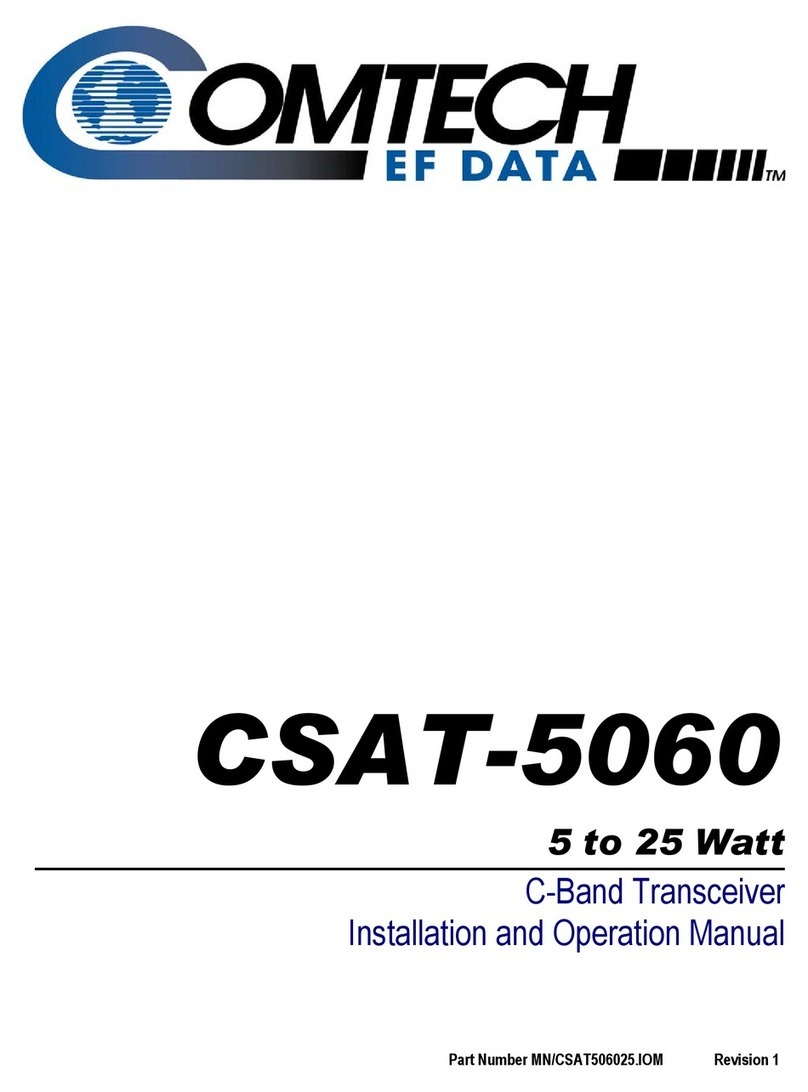
Comtech EF Data
Comtech EF Data CSAT-5060 Installation and operation manual
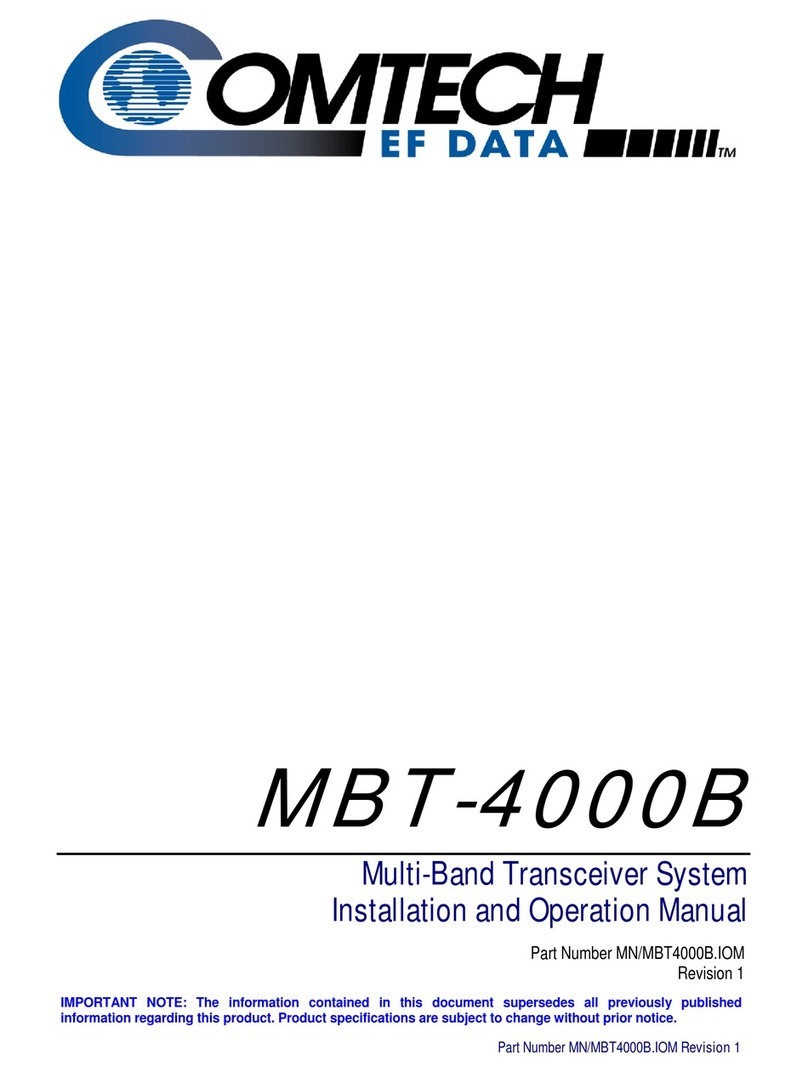
Comtech EF Data
Comtech EF Data MBT-4000B User's installation and operation manual
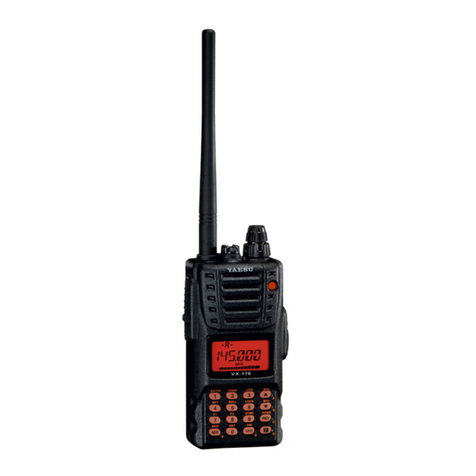
Yaesu
Yaesu VX-120 Series operating manual

Vertex Standard
Vertex Standard VXA-150 Service manual
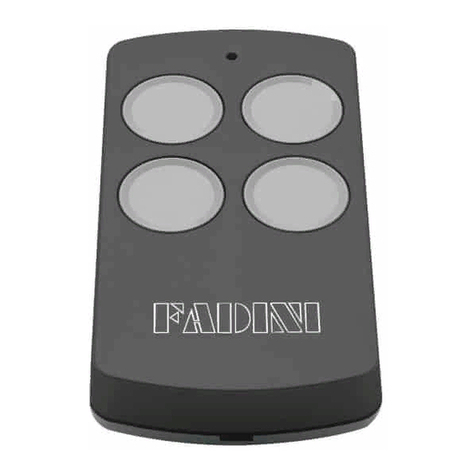
Meccanica Fadini
Meccanica Fadini VIX 53 manual

Yaesu
Yaesu FT-757GX II operating manual
